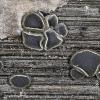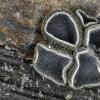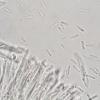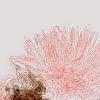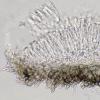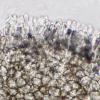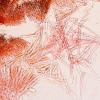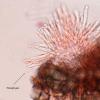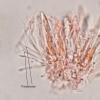
21-12-2025 21:32
Pol DebaenstHello, Garden, Burgweg 19, Veurne, BelgiumOn 10/1

22-12-2025 00:47
Patrice TANCHAUDBonsoir, récolte à proximité du milieu dunaire

21-12-2025 21:40
Isabelle CharissouBonjour, j'aimerais connaitre les références de

21-12-2025 21:31
Pol DebaenstHello, Garden, Burgweg 19, Veurne, BelgiumOn 10/1

21-12-2025 21:31
Pol DebaenstHello, Garden, Burgweg 19, Veurne, BelgiumOn 10/1

20-12-2025 23:08
Patrice TANCHAUDBonsoir, récolte sur sol sablonneux dans l'arri�

21-12-2025 09:32
Hello.A tiny ascomycete found embedded in wood in

20-12-2025 15:47
Mirek GrycHi.These grew on pine wood that was heavily covere
I believe this to be Pyrenopeziza chailletii (Pers.) Fuckel. That is, Fuckel's original description denoting spores 8 microns long.
Most later finds have spores averaging 17-22 microns and it was thought Fuckel had made a mistake.
Spores hyaline, 7.6-9.4 x 2.0-2.5 µm, with small drops at each end.
Asci 34-55 x 4.2-7.0 µm, paraphyses sparse and difficult to see.
A useful debate on the genus, and this species in particular, can be found here: http://www.wildaboutbritain.co.uk/forums/fungi-forums/47409-problem-pyrenopeziza.html
Any comments welcome.
Regards, Chris

I was unaware of this original spore size. But I think it would be the best to locate and reexamine type material in order to clarify the spore size and perhaps other characters.
But I see that Gremmen 1966: 401 (Nova Hedw. 11: 395-403) examined the type though I did not enter a spore size for this report in my database.
I am not sure whether the paraphyses in your specimen are lanceolate or not. Immature asci can easily be mistaken as paraphyses. Do you have a photo of clear paraphyses? Best more than only one paraphysis.
If lanceolate I would compare "Mollisiopsis" lanceolata which is a Pyrenopeziza.
If cylindrical I would compare Pyrenopeziza atrata.
What is the host genus for your find?
Cheers
Zotto
They were found at the base of an old Angelica sylvestris stem. Apothecia 0.3-1.0 mm across.
I'll have a look at another specimen and see if I can get a better look at the paraphyses.
Many thanks, Chris
Try to get as high resolution images of the ascospores as possible. Based on the Pyrenopeziza species I've sequenced for my PhD, I think the exact shape (and length-width variability) of the ascospores, and oil droplet content and distribution, are extremely important characters, especially when there are few other differences in apothecial morphology.
But I think the problem of Pyrenopeziza atrata and Fuckel's P. chailletii is that both the ascospores and apothecial morphology are fairly generic, and so I would expect this morphological species concept to be a morphological complex like Mollisia cinerea, i.e. comprising multiple phylogenetically distinct (and sometimes distantly related) species. Ascospore morphology in Pyrenopeziza can massively vary between sibling species, and be identical between distantly related species (including P. atrata-like ascospores), and so maybe distinctive larger or longer ascospores, or distinctive apothecia, only develop when under evolutionary pressure to adapt to particular host types or habitats. Otherwise apothecia and ascospores can often be fairly similar unless you compare them very closely, and even then you can't be 100% sure they're not just different phenotypes of the same species without DNA sequencing.
As for the host specificity:
From your WAB post: "Pyrenopeziza species in general are, as I understand it, limited to certain vascular plant genera or families, although there are some plurivorous ones (which perhaps await critical examination and splitting?)."
I don't think the available evidence supports that Pyrenopeziza species are generally host specific, or even limited to particular families. Some species (and small clades) are definitely highly co-evolved with their hosts - these are typically the really pathogenic ones, or asymptomatic endophytic species closely related to pathogens. But most of the others appear to be widespread and plurivorous endophytes and saprotrophs. For instance, one of my species that looks like Pyrenopeziza atrata (fruiting on an umbelliferous species in the UK, and on some type of Rumix-like dead plant stem on another site) has been found in seaweed rhizomes, and is a common root endophyte of Juniper in Hungary - and there many similar examples for other species. Some of my species were also able to fruit in culture, indicating they don't require a specific host to form apothecia and could potentially fruit on any suitable substrate. So I think using the plant host as a positive or negative taxonomic character should be treated with a bit of caution unless the species morphology is distinctive - although plant host/substrate is of course very useful information!
On the other hand, it could be that many plant-specific Pyrenopeziza species have not been detected in environmental surveys of plants and soils - but then the number of species in Pyrenopeziza might be over 200 or more (my current estimate is a very conservative minimum of 50-100 from GenBank sequences). In this case, the problem of generic- or similar-looking species could become even more problematic! (I don't think this is unlikely either!).
Cheers,
Brian
Thanks for your detailed input on this thread.
I don't have any scientific training or knowledge, so have to rely on those that do to make taxonomic and nomeclatural decisions. There are many instances where aggregate speces groups are the current state of knowledge, but I still think it important to try and hang a label on a find, even if it's necessary to review it when more information becomes available.
As a field worker, it's always nice to get a positive identification, but on numerous occasions this is not possible. I would like to think that what the field worker provides is a source of material for the professional to make use of.
Forums such as AscoFrance provide such a valuable service to the amateur mycologist and it would be nice to speculate that reciprocity is in the use of these data at some point in the future.
Regards,
Chris

As you mentioned the contents of Ascofrance, I want to say that I always download contributions on Helotiales and some other disco groups in my files, which are automatically uploaded. There they can be viewed by everyone.
You have acces via my homepage which is still under work:
http://www.invivoveritas.de/
Go to DVD-download (but you must not download, you can also view the images.
Zotto
I totally agree with you. And of course the whole point of taxonomic/systematics work is to benefit the end-users, which includes all the field mycologists who contribute so much to collecting species and establishing taxonomic concepts in the first place!
But I think it's also important to acknowledge when the identities are (or can be) a bit dubious, just to avoid difficulties down the line and to help improve species concepts by suggesting further work.
Anyway, I'd personally go with Pyrenopeziza cf. atrata or Pyrenopeziza cf. chailetti (Pers.) sensu Fuckel. I would feel much less comfortable claiming it IS that species until much more work has been done sequencing collections with similar morphology. I suppose it all depends on why you're trying to identify species.
I've seen a lot of problems in the Helotiales caused by people sequencing single insufficiently identified species and uploading these to GenBank, since such errors can easily propagate rapidly throughout databases and literature, and are very hard to fix. But an ID of P. atrata is certainly good enough for field mycological records until we know more, especially if people recognise that it might be a morphological species complex.
Cheers,
Brian
Zotto, what an archive! I'll get lost in there for weeks.
Chris

